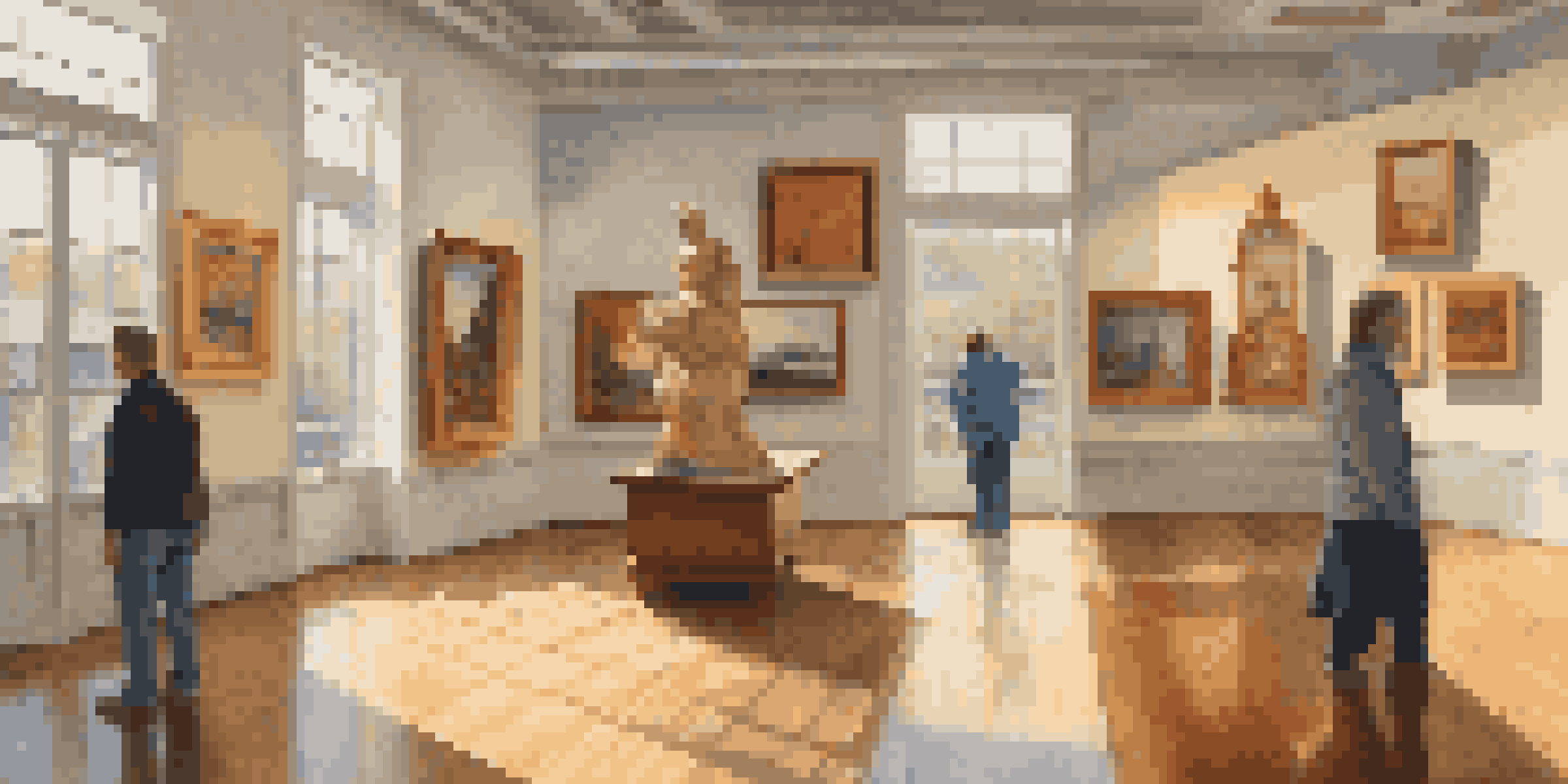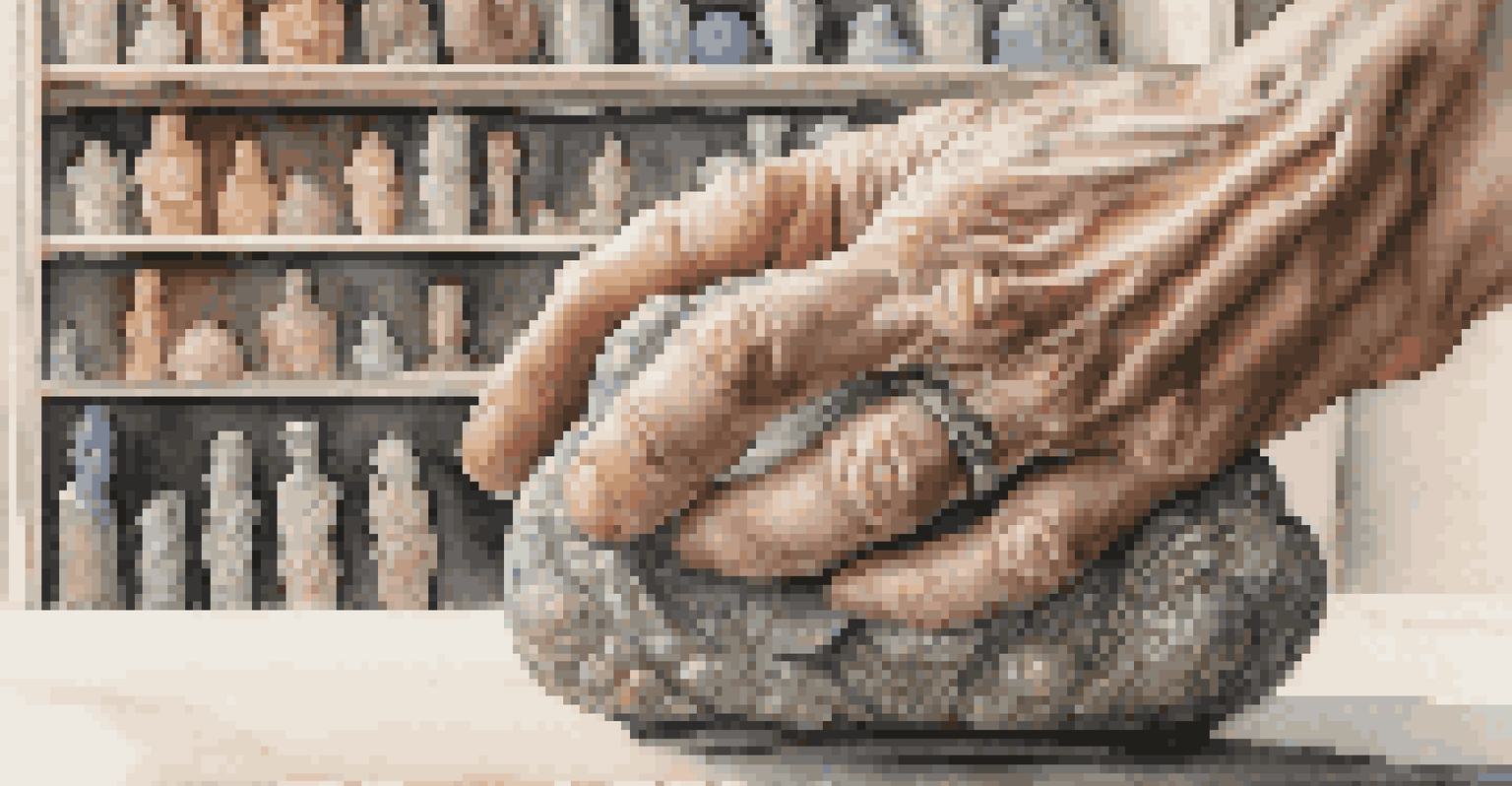Exploring the Emotional Connection Between Collectors and Art

The Heartbeat of Collecting: More Than Just Objects
Collecting art is often seen as a hobby, but for many, it’s a deeply emotional journey. Each piece tells a story, evoking memories and feelings that resonate with its owner. This connection transforms mere objects into treasured companions, enriching the collector’s life.
Art enables us to find ourselves and lose ourselves at the same time.
When a collector acquires a piece of art, it’s not just about the aesthetics; it’s about the emotions it ignites. Whether it’s the joy of discovery or the thrill of ownership, these feelings create a bond that goes beyond the canvas. Art becomes a reflection of the collector’s identity and experiences.
For instance, a painting might remind someone of a cherished moment in their past, turning it into a symbol of nostalgia. This emotional investment is what makes collecting art a uniquely personal experience, weaving the collector’s life story into the fabric of each artwork.
The Role of Memories in Art Collection
Every artwork can serve as a vessel for memories, capturing moments that are significant to the collector. When someone looks at a piece, they often remember when they acquired it or the feelings it stirred at that moment. This intertwining of art and memory deepens the emotional connection.

For example, a collector might possess a sculpture from their travels that reminds them of an unforgettable trip. Each time they see it, they’re transported back to that moment, feeling the same excitement and joy. This is why personal history plays such a crucial role in the art collection process.
Art Collecting as Emotional Journey
Collecting art transcends mere aesthetics, becoming a personal journey filled with emotions and memories that deeply connect collectors to their pieces.
These memories not only enhance the value of the artwork but also create a sense of belonging. Collectors often share these stories with others, forging connections and friendships in the art community, further enriching their collecting experience.
Art as a Reflection of Personal Identity
Art can be a powerful expression of individuality, allowing collectors to showcase their tastes and values. Each piece they choose reflects their personality, beliefs, and experiences, offering a glimpse into who they are. This makes art collection an intimate process, revealing layers of identity.
Collecting is not just about the objects; it's about the stories they tell and the emotions they evoke.
For instance, a collector who favors abstract art may appreciate the freedom of expression that comes with it. This choice not only speaks to their aesthetic preferences but also aligns with their worldview, emphasizing creativity and open-mindedness. Thus, the art they collect becomes a canvas of their identity.
As collectors curate their collections, they communicate their passions and ideals to the world. This bond with art helps to further solidify their identity, as they become known for their distinct tastes and the narratives their collections tell.
The Emotional Impact of Art on Well-Being
Engaging with art has been shown to have numerous emotional benefits, enhancing mental health and overall well-being. Collectors often find joy and solace in their collections, using art as a source of inspiration or comfort. This emotional impact can be profound, shaping daily life in meaningful ways.
For instance, a collector might find a sense of peace while observing a serene landscape painting, allowing it to serve as a refuge from daily stresses. Art can create a space for reflection and mindfulness, promoting emotional healing and growth. It’s no wonder that many collectors describe their art as a source of therapy.
Memories Enhance Art's Value
Each artwork serves as a vessel for cherished memories, enriching the collector's emotional experience and fostering a sense of belonging within the art community.
Moreover, the act of collecting itself can be a fulfilling pursuit, offering a sense of purpose and accomplishment. This emotional connection fosters a positive relationship with art, presenting it not merely as a collection of pieces but as a vital part of life.
Community and Connection Among Collectors
The world of art collecting often fosters strong connections among like-minded individuals. Collectors frequently bond over shared interests, attending galleries or exhibitions together, creating a sense of community. This camaraderie adds another layer to the emotional connection with art.
Through these interactions, collectors exchange stories about their pieces, share insights, and even offer advice on acquisitions. These relationships can lead to lasting friendships, as they find common ground in their passion for art. It becomes a platform for building connections that transcend the artworks themselves.
Additionally, the art community provides support and encouragement, helping collectors navigate their emotional journeys with art. This sense of belonging enhances the overall collecting experience, making it even more fulfilling.
The Journey of Finding the Perfect Piece
The search for that perfect artwork can be an exhilarating adventure, filled with anticipation and excitement. Collectors often experience a rush of emotions as they explore galleries, auctions, and online platforms, seeking out pieces that resonate with them. This journey becomes a significant part of their emotional connection with art.
Each discovery brings with it a wave of joy, as well as the thrill of potential ownership. The moment a collector lays eyes on a piece that speaks to them, it can feel as if they’ve uncovered a hidden treasure. This exhilarating pursuit is what keeps many collectors engaged and passionate about their hobby.
Art as a Reflection of Identity
The pieces collectors choose reveal their individuality, beliefs, and experiences, making art collection an intimate process that showcases personal identity.
Ultimately, the journey of collecting is about more than just the art; it’s about the experiences, the emotions, and the stories that unfold along the way. Each piece acquired becomes a chapter in a larger narrative, making the collecting process rich and fulfilling.
The Legacy of Art and Its Emotional Resonance
Art collections often carry a legacy that extends beyond the individual collector. The emotional connection to these pieces can be passed down through generations, creating a family history intertwined with art. This aspect of collecting adds depth to the emotional ties that bind people to their artworks.
For many collectors, the idea of leaving behind a collection can evoke feelings of pride and nostalgia. They envision their children or loved ones cherishing the pieces that once brought them joy, fostering a sense of continuity. This legacy can serve as a bridge between past and future, connecting different generations through shared experiences with art.

Moreover, the stories behind each piece become part of the family narrative, enriching the emotional landscape for future generations. This lasting impact highlights the profound nature of art, not just as visual objects, but as emotional legacies that resonate across time.